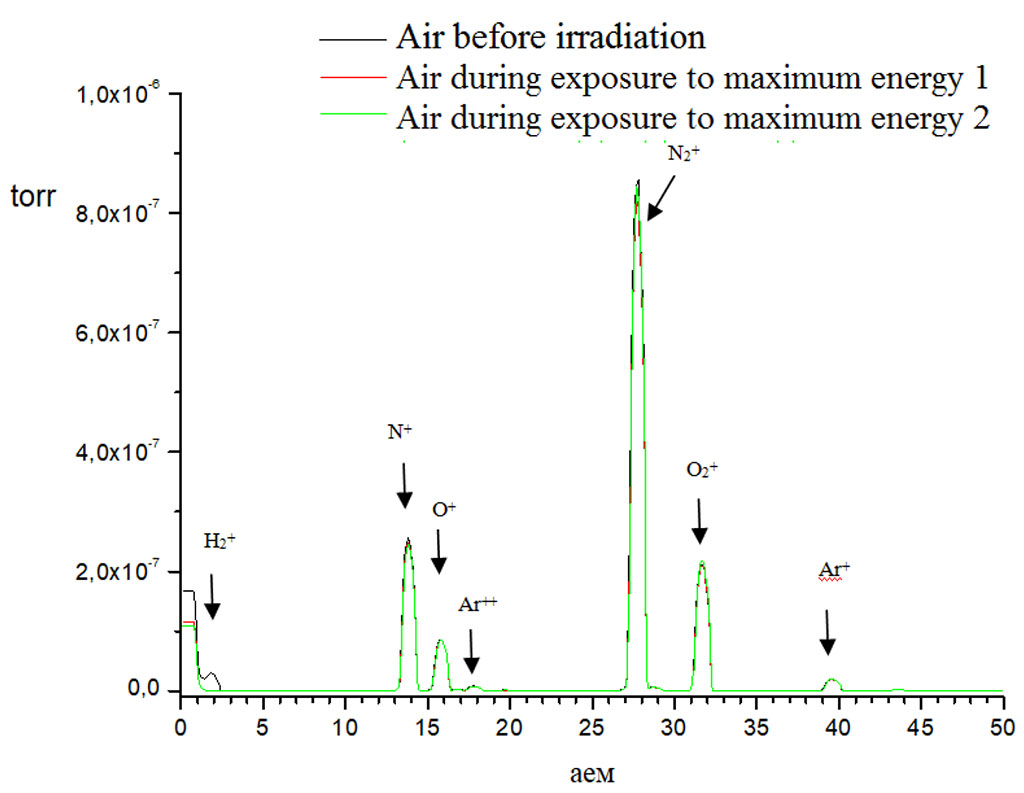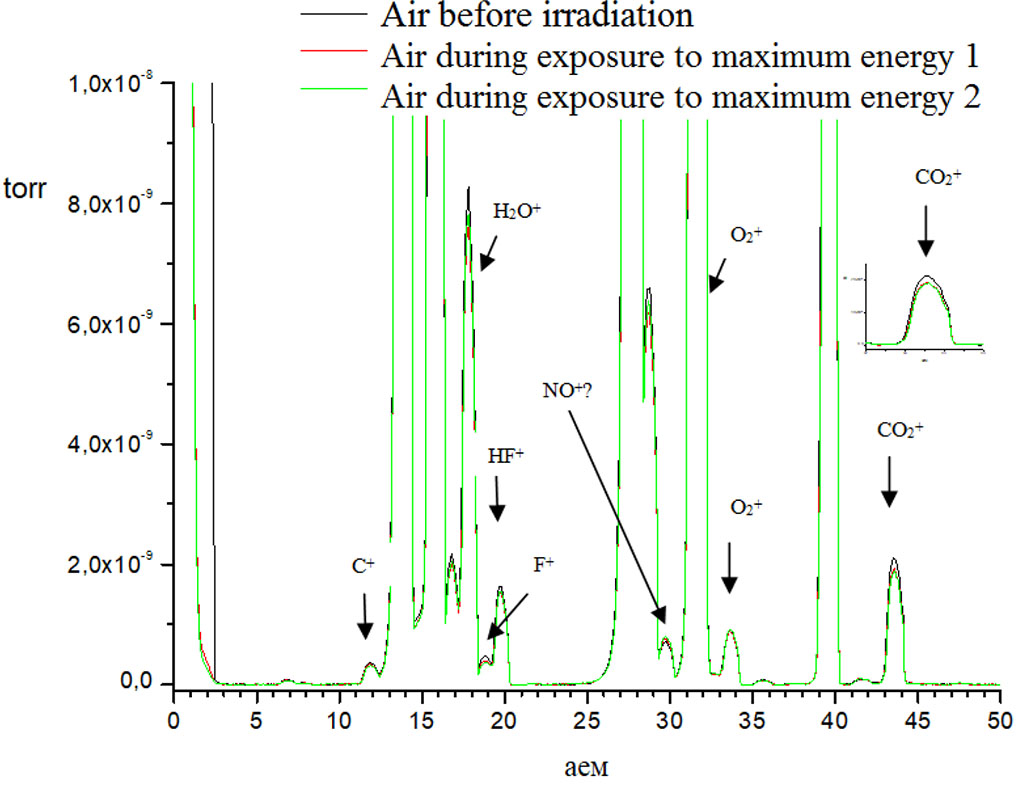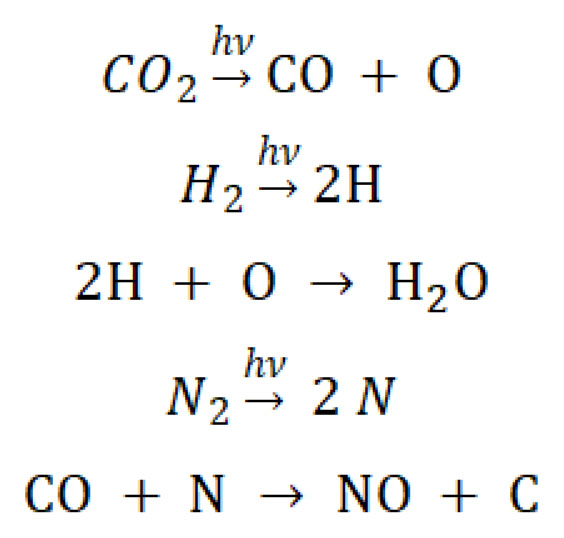- Home
- About the Journal
- Peer Review
- Editorial Board
- For Authors
- Reviewer Recognition
- Archiv
- Kontakt
- Impressum
- EWG e.V.
Cite as: Archiv EuroMedica. 2022. 12; 4: e1. DOI 10.35630/2199-885X/2022/12/4.5
The purpose of this study was to clarify the composition of the gas flow from the singlet oxygen generator and its features relative to air as a carrier gas. The mass spectra of the exhaust gases were recorded by a quadrupole mass spectrometer Extorr XT 300(M) Series VGA with a resolution of 1 atomic unit of mass (aem). The spectrum of the gas flow was analyzed in the standard operating mode of the "Airnergy" generator, as well as when shielding the aqueous medium from radiation with an impermeable membrane for it. The spectra were evaluated by the presence of characteristic bands of particle mass. It is revealed that the treatment of the air flow in the "Airnergy" apparatus, including its humidification and exposure to UV radiation, significantly transforms its qualitative and quantitative composition. In the outgoing stream, a decrease in the level of carbon dioxide and molecular oxygen is detected with a simultaneous increase in the concentration of nitric monoxide (NO). This circumstance has a special biological significance, since the presence of this compound in the gas stream from the singlet oxygen generator can complement and transform the effects of this reactive oxygen species in relation to biological systems.
Keywords: singlet oxygen, nitric oxide, gas flow, mass spectrometry
Over the past two decades, we and other researchers have shown the beneficial effects of the use of singlet oxygen in relation to biological systems of various levels (from isolated samples of biological fluid to the human body and laboratory animals) [3-6]. At the same time, it was found that the treatment of biosystems with singlet oxygen provides activation of the antioxidant potential without stimulation of free radical oxidation [1, 4, 7], intensification of the energy metabolism of cells and detoxification enzymes in them [3, 4, 8], etc. Among the functional effects of the studied effect, it should be noted the activation of blood flow through small-diameter vessels (capillary bed), carried out due to the increase in the endothelial component of microcirculation regulation [5]. It is known that the latter directly depends on the release of nitrogen monoxide by the vascular wall and molecular depots (dinitrosyl iron complexes and S-nitrosothiols present in blood plasma) [1-3]. On this basis, it can be assumed that a number of effects of singlet oxygen therapy may be associated with the presence of NO in the gas stream from the singlet oxygen generator, however, there are no such studies to date. With this in mind, the purpose of this study was to clarify the composition of the gas flow from the singlet oxygen generator and its features relative to air.
The composition of the gas flow from the singlet oxygen generator was studied by gas mass spectrometry, for which the working gas from the generator was directly supplied to the analyzer. Atmospheric air is used as a carrier gas in this device, which is processed by exposure to UV radiation passing through an aqueous medium. For this purpose, bidistilled water is used in the "Airnergy Professional plus" device.
The mass spectra of the exhaust gases were recorded by a quadrupole mass spectrometer Extorr XT 300(M) Series VGA with a resolution of 1 atomic unit of mass (aem). The residual vacuum in the mass spectrometer chamber was 5•10-8 Torr. The working pressure varied from 1•10-6 to 1•10-4 Torr. The spectrum of the gas flow was analyzed in the standard operating mode of the "Airnergy" generator, as well as when shielding the aqueous medium from radiation with an impermeable membrane for it. The spectra were evaluated by the presence of characteristic bands of particle mass.
The initial spectrum of the untreated UV-irradiated air flow is shown in Figure 1. Characteristic bands of nitrogen (molecular and atomic), hydrogen, oxygen (molecular and atomic) and argon are distinguished on it.

Fig. 1. Air mass-spectra of gas flow from “Airnergy” device (without irradiation)

Fig. 2. Air mass-spectra of gas flow from “Airnergy” device (with UV irradiation)
It is established that the treatment of humidified atmospheric air with UV radiation leads to a significant transformation of the qualitative and quantitative composition of the gas flow from the "Airnergy" generator (Fig. 2).
The figures 1 and 2 show the mass spectra of air without irradiation and when irradiated on the "Airnergy" device. The following changes in the air mass spectra are observed during irradiation:
With a signal-to-noise ratio of about 1 • 10 -11 Torr, there are no new bands at the level of 10-30 ppm.
According to the conducted studies, it can be assumed that the CO2 molecule under the action of radiation passes into NO and H2O as a result of the following reactions:

Such a chain of transformations of the components of the gas stream suggests that when it is treated with UV radiation in the mode created in the generator in question, a certain amount of nitrogen monoxide can be synthesized. This compound, having a wide range of biological functions, is able to complement the effects of singlet oxygen. Thus, the stimulation of microcirculation and an increase in the overall antioxidant activity observed when the biosystems are exposed to the flow from the "Airnergy" generator can be additionally associated with the formation of NO de novo.
It is revealed that the treatment of the air flow in the "Airnergy" apparatus, including its humidification and exposure to UV radiation, significantly transforms its qualitative and quantitative composition. In the outgoing stream, a decrease in the level of carbon dioxide and molecular oxygen is detected with a simultaneous increase in the concentration of nitric monoxide (NO). This circumstance has a special biological significance, since the presence of this compound in the gas stream from the singlet oxygen generator can complement and transform the effects of this reactive oxygen species in relation to biological systems.